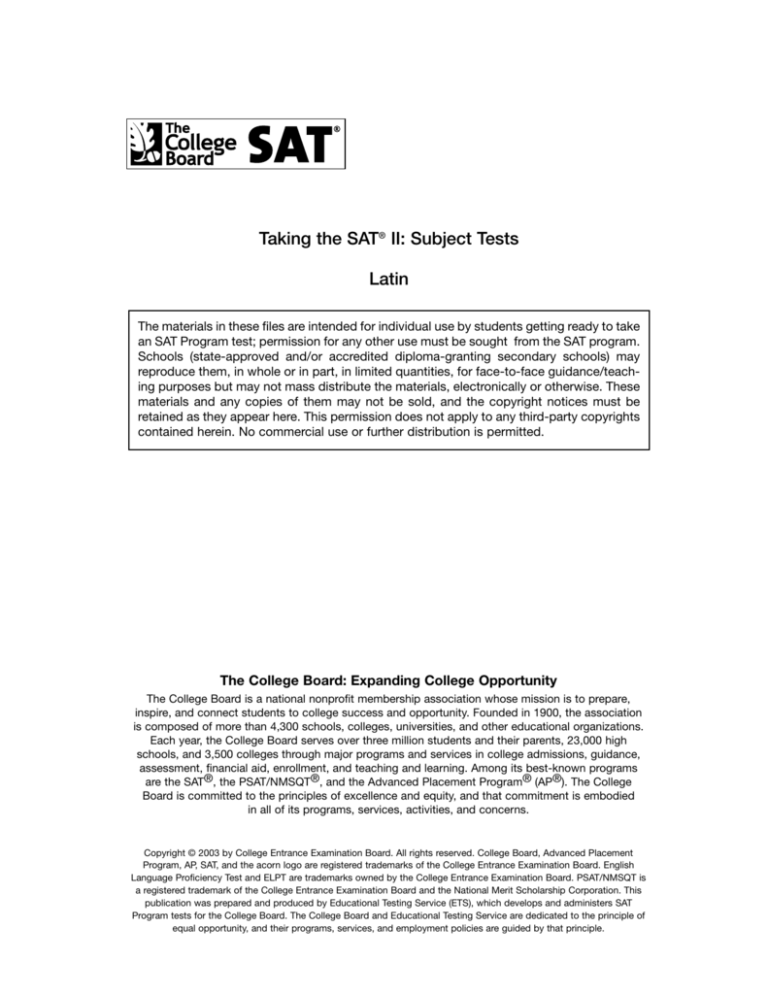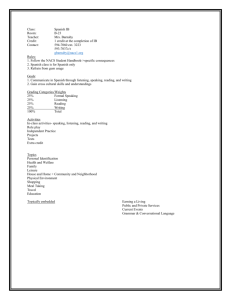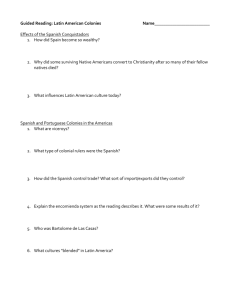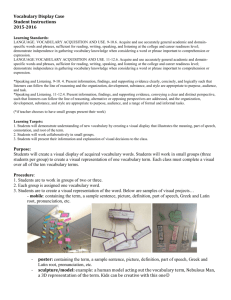
Taking the SAT® II: Subject Tests
Latin
The materials in these files are intended for individual use by students getting ready to take
an SAT Program test; permission for any other use must be sought from the SAT program.
Schools (state-approved and/or accredited diploma-granting secondary schools) may
reproduce them, in whole or in part, in limited quantities, for face-to-face guidance/teaching purposes but may not mass distribute the materials, electronically or otherwise. These
materials and any copies of them may not be sold, and the copyright notices must be
retained as they appear here. This permission does not apply to any third-party copyrights
contained herein. No commercial use or further distribution is permitted.
The College Board: Expanding College Opportunity
The College Board is a national nonprofit membership association whose mission is to prepare,
inspire, and connect students to college success and opportunity. Founded in 1900, the association
is composed of more than 4,300 schools, colleges, universities, and other educational organizations.
Each year, the College Board serves over three million students and their parents, 23,000 high
schools, and 3,500 colleges through major programs and services in college admissions, guidance,
assessment, financial aid, enrollment, and teaching and learning. Among its best-known programs
are the SAT®, the PSAT/NMSQT®, and the Advanced Placement Program® (AP®). The College
Board is committed to the principles of excellence and equity, and that commitment is embodied
in all of its programs, services, activities, and concerns.
Copyright © 2003 by College Entrance Examination Board. All rights reserved. College Board, Advanced Placement
Program, AP, SAT, and the acorn logo are registered trademarks of the College Entrance Examination Board. English
Language Proficiency Test and ELPT are trademarks owned by the College Entrance Examination Board. PSAT/NMSQT is
a registered trademark of the College Entrance Examination Board and the National Merit Scholarship Corporation. This
publication was prepared and produced by Educational Testing Service (ETS), which develops and administers SAT
Program tests for the College Board. The College Board and Educational Testing Service are dedicated to the principle of
equal opportunity, and their programs, services, and employment policies are guided by that principle.
Latin
one-hour subject test
Sample Questions
PURPOSE
❚ measure wide-ranging knowledge of Latin
Six types of questions are used in the Latin Test. All questions in the test are multiple-choice questions in which
you must choose the BEST response from the four choices
offered.
FORMAT
❚ 70-75 multiple-choice questions
Areas of Evaluation
The test questions ask you to:
❚ select appropriate grammatical forms of Latin words
❚ choose Latin words from which English words are
derived
❚ translate from Latin to English
❚ complete Latin sentences
❚ choose alternate ways of expressing the same
thought in Latin
❚ answer a variety of questions based on short
passages of prose or poetry
The reading comprehension part has 30 to 37 questions
based on three to five reading passages and one or two
poetry passages. A set of questions following a poetry passage always includes one question requiring you to scan
the first four feet of a line of dactylic hexameter verse or
to determine the number of elisions in a line.
Note: In some questions in this test variations of Latin
terms will appear in parentheses.
Directions: In each statement below, you are asked to
give a specific form of the underlined word. Select the
correct form from the choices given. Then fill in the
corresponding oval on the answer sheet.
1. The dative singular of senatus is
(A) senatu (B) senatum (C) senatus (D) senatui
2. The nominative plural neuter of fortior is
(A) fortiores (B) fortiori (C) fortiorum (D) fortiora
3. The present subjunctive passive of capitis is
(A) capiamini (B) capiemini
RECOMMENDED PREPARATION
(C) caperemini (D) capimini
❚ 2-4 years of Latin study in high school (the equivalent
of two to four semesters in college)
❚ gradual development of competence in sight-reading Latin
over a period of years
SCORE
Directions: Each of the following English sentences
contains a word that is underlined. From among the
choices, select the Latin word to which the underlined
word is related by derivation. Then fill in the corresponding oval on the answer sheet.
❚ Total score: 200-to-800 scale
CONTENT
Approximate
% of Test
4. The transition from adolescence to adulthood was
easy.
(A) sedere (B) ire (C) ferre (D) esse
Skills Measured
Grammar and syntax
Derivatives
30
5
Translation and reading comprehension
65
5. All things are possible.
(A) pono (B) possum (C) possideo (D) posco
Taking the SAT II: Subject Tests
67
Directions: In each of the sentences below, part or
all of the sentence is underlined. From among the
choices, select the best translation for the underlined
word or words. Then fill in the corresponding oval on
the answer sheet.
Directions: In each of the sentences below, part or all
of the sentence is underlined. Select from the choices
the expression that, when substituted for the underlined portion of the sentence, changes the meaning of
the sentence LEAST. Then fill in the corresponding
oval on the answer sheet.
6. Si vocavisses, laeti fuissemus.
(A)
(B)
(C)
(D)
If
If
If
If
you
you
you
you
were calling
had called
are calling
should call
11. Fortes a consule semper laudantur.
(A) Consul a fortibus semper laudatur.
(B) Consul fortes semper laudat.
(C) Fortes consulem semper laudant.
(D) Consules fortes semper laudantur.
7. Agricola dixit se puellam visurum esse.
(A)
(B)
(C)
(D)
that
that
that
that
he would see the girl
he had seen the girl
the girl would see him
they will see the girl
12. Cives venerunt ut pacem peterent.
(A) ad pacem petendam
(B) pace petita
(C) si pax peteretur
8. Iter militibus faciendum est.
(A)
(B)
(C)
(D)
The
The
The
The
journey was made by the soldiers.
journey is being made by the soldiers.
soldiers must make a journey.
soldiers have made a journey.
(D) postquam pax petebatur
Directions: Read the following texts carefully for comprehension. Each is followed by a number of questions
or incomplete statements. Select the answer or completion that is best according to the text and fill in the
corresponding oval on the answer sheet.
Directions: Each of the sentences below contains a
blank space indicating that a word or phrase has
been omitted. For each blank, four completions are
provided. Choose the word or phrase that best
completes the sentence and fill in the corresponding
oval on the answer sheet.
Honors for an emperor
Line
(5)
9. Servus . . . vulneratur.
(A) a saxo (B) saxum (C) cum saxo (D) saxo
Cum igitur in amore omnium Marcus Antoninus
bene regnavisset, octavo decimo anno imperii sui
mortuus est. Priusquam funus celebratum est,
senatus populusque eum deum esse dixit. Mox nemo
erat qui eius (ejus) imaginem in sua domo non haberet,
hodieque in multis domibus Marci Antonini statuae
consistunt inter Penates. Neque defuerunt homines
qui crederent in somnis eum multa quae vera essent
praedixisse.
10. Vidisti . . . patriam incolunt.
(A) quos (B) qui (C) quem (D) cui
13. In line 2, octavo decimo anno is translated
(A)
(B)
(C)
(D)
68
Taking the SAT II: Subject Tests
for eighteen years
after eighteen years
in the eighteenth year
throughout the eighteenth year
14. The first two sentences (Cum . . . dixit) tell us that
(A) Antoninus arranged his own funeral before he
died
(B) everyone celebrated Antoninus’ funeral for
eighteen days
(C) a god told the senate and people to celebrate
Antoninus’ funeral
(D) Antoninus was proclaimed a god by the senate
and people
17. In line 9, praedixisse is translated
(A)
(B)
(C)
(D)
18. The last sentence (Neque . . . praedixisse) tells
us that
(A) people do not always believe their dreams
(B) Marcus Antoninus was believed to prophesy in
dreams
(C) Marcus Antoninus believed in the truth of many
dreams
(D) people predicted that many would believe their
dreams
15. In line 5, sua refers to
(A)
(B)
(C)
(D)
would predict
had predicted
predicts
will have predicted
deum (line 4)
nemo (line 4)
eius (ejus) (line 5)
imaginem (line 5)
16. The third sentence (Mox . . . Penates) tells us that
(A) Antoninus placed statues of the household gods
in every home
(B) no one had a statue of Antoninus
(C) many statues of Antoninus replaced the
household gods
(D) many houses had statues of Antoninus among the
household gods
ANSWERS
The estimated difficulty level, on a scale of 1 to 5,
with 1 the easiest and 5 the most difficult, is in
parentheses.
1.
2.
3.
4.
5.
D
D
A
B
B
(3)
(3)
(4)
(3)
(1)
6.
7.
8.
9.
10.
B
A
C
D
B
(3)
(4)
(4)
(3)
(4)
11.
12.
13.
14.
B
A
C
D
(4)
(3)
(3)
(3)
15.
16.
17.
18.
B
D
B
B
(4)
(3)
(3)
(4)
Taking the SAT II: Subject Tests
69
Taking the SAT® II: Subject Tests
Spanish and Spanish with Listening
The materials in these files are intended for individual use by students getting ready to take
an SAT Program test; permission for any other use must be sought from the SAT program.
Schools (state-approved and/or accredited diploma-granting secondary schools) may
reproduce them, in whole or in part, in limited quantities, for face-to-face guidance/teaching purposes but may not mass distribute the materials, electronically or otherwise. These
materials and any copies of them may not be sold, and the copyright notices must be
retained as they appear here. This permission does not apply to any third-party copyrights
contained herein. No commercial use or further distribution is permitted.
The College Board: Expanding College Opportunity
The College Board is a national nonprofit membership association whose mission is to prepare,
inspire, and connect students to college success and opportunity. Founded in 1900, the association
is composed of more than 4,300 schools, colleges, universities, and other educational organizations.
Each year, the College Board serves over three million students and their parents, 23,000 high
schools, and 3,500 colleges through major programs and services in college admissions, guidance,
assessment, financial aid, enrollment, and teaching and learning. Among its best-known programs
are the SAT®, the PSAT/NMSQT®, and the Advanced Placement Program® (AP®). The College
Board is committed to the principles of excellence and equity, and that commitment is embodied
in all of its programs, services, activities, and concerns.
Copyright 2003 by College Entrance Examination Board. All rights reserved. Advanced Placement, AP, College Board, SAT,
and the acorn logo are registered trademarks of the College Entrance Examination Board. PSAT/NMSQT is a registered
trademark of the College Entrance Examination Board and National Merit Scholarship Corporation. This publication was
prepared by Educational Testing Service (ETS), which develops and administers SAT Program tests for the College Board.
The College Board and Educational Testing Service are dedicated to the principle of equal opportunity, and their programs,
services, and employment policies are guided by that principle.
Spanish and
g
Spanish
with Listening
p
-hour subject tests
one-hour
SPECIAL INFORMATION
Spanish Test with Listening
❚ offered only in November at designated test centers
❚ You must bring an acceptable cassette player with
earphones to take the test. See page 5.
Part B questions test your ability to identify a plausible
continuation of a short conversation.
Part C requires that you answer comprehension questions based on more extensive listening selections.
RECOMMENDED PREPARATION
PURPOSE
Spanish Test
❚ evaluate reading skills through precision of vocabulary and
structure use and comprehension of a variety of texts
Spanish Test with Listening
❚ measure the ability to understand written and spoken
Spanish
FORMAT
Both tests reflect general trends in high school curricula
and are independent of particular textbooks or methods
of instruction. Recommended preparation includes:
❚ 3-4 years of study in high school or the equivalent (2 years
for outstanding students)
❚ gradual development of competence in Spanish over a period
of years
Spanish Test with Listening
❚ a practice cassette with sample questions is available
from your school counselor
Spanish Test
❚ 85 multiple-choice questions
SCORE
Spanish Test with Listening
❚ Total score: 200-to-800 scale
❚ Listening Test: reading and listening subscores
20-to-80 scale
❚ 20 minutes listening and 40 minutes reading
❚ 85 multiple-choice listening and reading questions
Reading Section
Reading questions implicitly test vocabulary throughout
the test, but some questions specifically test word meaning
in the context of a sentence that reflects spoken or written
language. Understanding of various parts of speech (nouns,
verbs, adjectives, adverbs, etc.) and idiomatic expressions
is tested. The reading section also asks:
Structure Questions. These questions ask you to identify
usage that is both structurally correct and contextually
appropriate. Other reading questions test vocabulary
and grammatical usage in longer paragraphs.
Reading Questions. These questions are based on selections from prose fiction, historical works, newspaper
and magazine articles, as well as advertisements,
flyers, and letters. They test points such as main and
supporting ideas, themes, style, tone, and the spatial
and temporal settings of a passage.
SPANISH
Skills Measured
Vocabulary and structure
33
Paragraph completion
33
Reading comprehension
33
SPANISH with LISTENING
Pictures
Rejoinders
Selections
The listening section has three parts:
Part A questions ask you to identify the sentence that
most accurately describes what is presented in a
photograph or what someone in the photograph
might say.
Reading Section (40 minutes/about 55 questions)
Taking the SAT II: Subject Tests
Approximate
% of Test
Listening Section (about 20 minutes/30 questions) 40
Listening Section
70
Approximate
% of Test
Vocabulary and structure
Paragraph completion
Reading comprehension
60
Sample Reading
Questions
There are three types of reading questions, grouped into
separate parts. Each part accounts for approximately
one-third of the total score. All questions in the test are
multiple-choice questions in which you must choose the
BEST response from the four choices offered.
PART B
Directions: In each of the following paragraphs, there
are numbered blanks indicating that words or phrases
have been omitted. For each numbered blank, four
completions are provided. First, read through the
entire passage. Then, for each numbered blank, choose
the completion that is most appropriate given the context of the entire paragraph and fill in the corresponding oval on the answer sheet.
La máquina más infernal de hacer dinero se
PART A
Directions: This part consists of a number of incomplete statements, each having four suggested completions. Select the most appropriate completion and fill
in the corresponding oval on the answer sheet.
llama “Pedroso”, un osito electrónico que
(5)
ha
derramado sobre sus fabricantes beneficios superiores a los 100 millones de dólares en el
año. La
(7)
(6)
de Pedroso es que habla. Claro, no
hay ningún misterio en la cinta sin fin y el grabador
1. En Córdoba, uno de los grandes centros culturales
de España, se – – – – – – – libros del hebreo y del
árabe al latín.
(A) mudaban
(B) trasladaban
(C) impresionaban
(D) traducían
(8)
en el interior del osito. Pero lo
doso es que
(9)
nove-
hablar su boca se mueve en
(10)
sincronía con las palabras y sus ojos pestañean. El
juguete
vende a precios que oscilan entre
(11)
60 y 80 dólares.
2. Los cubanos están muy orgullosos de – – – – – – –
larga tradición folklórica.
(A) suyos
(B) sus
(C) suya
(D) su
3. Se sabe que la playa de Luquillo es muy popular
porque la gente de San Juan la visita – – – – – – –.
(A) en resumidas cuentas
(B) en punto
(C) a medias
(D) a menudo
4. Si – – – – – – – en el Brasil, hablaríamos portugués
y no español.
(A) vivamos
(B) vivimos
(C) vivíamos
(D) viviéramos
5. (A) todavía
(B) nunca
(C) ya
(D) tampoco
6. (A) primero
(B) primer
(C) primo
(D) primario
7. (A) oportunidad
(C) desventaja
(B) mayoría
(D) particularidad
8. (A) ocultos
(B) lejanos
(C) cobrados
(D) llenos
9. (A) verdaderamente
(C) ansiosamente
10. (A) del
11. (A) se
(B) en
(B) le
(B) antiguamente
(D) perezosamente
(C) al
(C) lo
(D) de
(D) los
Taking the SAT II: Subject Tests
71
PART C
Directions: Read the following texts carefully for comprehension. Each text is followed by a number of
questions or incomplete statements. Select the answer
or completion that is BEST according to the passage
and fill in the corresponding oval on the answer sheet.
Alcanzó la carretera central y pisó el acelerador. Se
cruzó con varios camiones del ejército y con una
ambulancia de la Cruz Roja. Sara hablaba incoherentemente a su lado.
—Pararemos en algún lugar. Un café nos hará bien.
En Santa Fe cayeron las primeras gotas. Álvaro las
vio caer en los cristales como frutas maduras y, a
los pocos segundos, el espacio se convirtió en una
cortina de agua. Era la lluvia violenta del trópico
acompañada de un viento colérico y del fuego brutal
de los relámpagos. Los limpiacristales oscilaban
inútilmente en abanico con un ruido sordo.
12. ¿Dónde se desarrolla esta narración?
(A) En una casa
(C) En un café
(B) En un automóvil
(D) En un cuartel
13. ¿Qué desea Álvaro?
(A) Abrir la cortina
(C) Tomar un café
(B) Comer una fruta
(D) Encender la luz
La tranquilidad de sentirse bien atendido.
15. ¿Qué característica se destaca más de la compañía
anunciada?
(A) Su precio
(B) Su cortesía
(C) Su rapidez
(D) Su amplitud
Sample Listening
Questions
In addition to the types of reading questions discussed
above, the Spanish Test with Listening has three types
of listening questions that test your ability to understand
spoken Spanish.
Please note that in the actual test, the listening section
comes first.
PART A
Directions: For each question in this part, you will hear
four sentences designated (A), (B), (C), and (D). They
will not be printed in your test booklet. As you listen,
look at the picture in your test booklet and select the
choice that best reflects what you see in the picture or
what someone in the picture might say. Then fill in the
corresponding oval on your answer sheet. You will
hear the choices only once.
You see:
1.
Cuando viaje por negocios, por
ocio o por estudios, disfrute
plenamente de la tranquilidad
de viajar bien atendido con
EUROPEA DE SEGUROS y
despreocúpese de accidentes,
asistencia médica, equipajes,
anulaciones, demoras, etc.
Viaje tranquilo. EUROPEA
pone a su disposición el seguro
más amplio y más completo
para cada tipo de viaje.
14. ¿Cuál de los siguientes beneficios ofrece esta
compañía de seguros?
(A) Reparación de autos
(B) Ayuda financiera
(C) Protección al viajar
(D) Servicios de día y noche
72
Taking the SAT II: Subject Tests
You hear:
[Número 1
(Woman)
(A) Siempre quise ser florista.
(B) Sólo hay una persona haciendo cola.
(C) Las cebollas están baratas hoy.
(D) Creo que está por aquí.]
(7 seconds)
PART B
You read:
Directions: In this part of the test you will hear several
short conversations or parts of conversations, followed by
four choices designated (A), (B), (C), and (D). After you
hear the four choices, choose the one that most logically
continues or completes the conversation and mark your
answer on your answer sheet. Neither the conversations
nor the choices will be printed in your test book.
Selección número 1
4.
¿Para cuándo quedan entradas?
(A) Para la tarde.
(B) Para el sábado.
(C) Para el domingo.
(D) Para la próxima semana.
You hear:
[Número 2
(Woman)
(Man)
5.
Ana es una ciclista excelente.
¿Qué programa presentan el domingo?
(A) Una comedia.
(B) Una ópera.
(C) Un concierto.
(D) Un ballet.
(A) Yo tengo una camiseta nueva.
(B) La mía es mucho mejor.
(C) Y además, es muy simpática.
(D) La motocicleta también es buena.]
(7 seconds)
You hear:
You hear:
[Número 3
(Woman)
[Selección número 2
¿Algo más, señor? Tenemos unas
ofertas especiales hoy.
(Man)
No, gracias. ¿Puedo pagar con tarjeta de crédito?
(Woman)
(A) Claro que sí.
(B) Salga usted ahora mismo.
(C) No aceptamos monedas.
(D) No, no tengo cambio.]
(7 seconds)
(Narrator)
Y ahora, el pronóstico del tiempo.
(Man)
Para mañana se anuncian fuertes
aguaceros en la zona de la costa.
Posibilidad de inundaciones en algunas áreas. Temperatura máxima de 25
grados centígrados. Leve mejora a
partir del sábado.
(Narrator)
Ahora contesten la pregunta 6.]
(12 seconds)
You read:
PART C
Selección número 2
Directions:You will now hear a series of selections. For
each selection, you will see printed in your test booklet
one or more questions with four possible answers. They
will not be spoken. Select the best answer to each question from among the four choices printed and fill in the
corresponding oval on your answer sheet. You will have
twelve seconds to answer each question.
6.
¿Qué se anuncia para el día siguiente?
(A) Sol.
(B) Lluvia.
(C) Viento.
(D) Frío.
ANSWERS
You hear:
[Selección número 1
(Narrator)
Escuchen esta conversación en la
taquilla del Teatro Colón.
(Man)
Buenas tardes, señorita. ¿Todavía hay
entradas para el programa del sábado? Necesito dos.
(Woman)
No, ya no quedan.
(Man)
Entonces, ¿para el domingo?
(Woman)
Ah, sí, para el domingo sí hay.
(Man)
¿Es el mismo programa?
(Woman)
No, es diferente; es un concierto de
música clásica.
(Man)
Entonces, deme dos entradas, por favor.
(Narrator)
Ahora contesten las preguntas 4 y 5.]
The estimated difficulty level, on a scale of 1 to 5,
with 1 the easiest and 5 the most difficult, is in
parentheses.
Reading Questions
5.
1. D (2)
6.
2. D (1)
7.
3. D (3)
8.
4. D (5)
C
B
D
A
(3)
(2)
(3)
(3)
Listening Questions
1. D (2)
3. A (3)
2. C (3)
4. C (2)
9.
10.
11.
12.
A
C
A
B
(3)
(3)
(3)
(2)
13. C (2)
14. C (3)
15. D (5)
5. C (2)
6. B (4)
(24 seconds)
Taking the SAT II: Subject Tests
73








